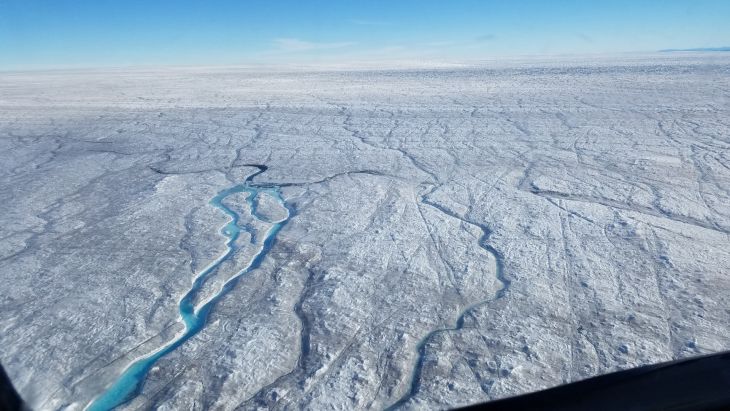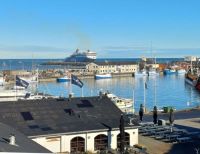18 lakes on the ice sheet have collapsed, and the water from them is causing glaciers to slide faster towards the sea, according to new international research with contributions from DTU Space. The new knowledge is important for understanding climate change in the Arctic.
In the middle of winter in 2018, an almost 50-year-old meltwater lake disappeared from the ice sheet in western Greenland.
The lake was covered by snow and ice when it collapsed but stored liquid water inside. The water disappeared into newly formed cracks in the ice and drifted down through the approximately 2 km thick layer of ice. The water hit the rock bed under the ice and flowed out from under the ice sheet towards the sea.
This meltwater acted as lubrication between the rock bed and the thick ice on top. As a result, the large mass of ice could slide faster towards the coast, accelerating an unusually large region of inland ice and exposing it further to the risk of melting.
The drainage of this lake caused other lakes in the area to collapse too. In total, the collapsed lakes have released approximately 180 million tonnes of meltwater that has ended up in the world's oceans. This is shown by new international research based on satellite data and led by the French Université Grenoble Alpes with contributions from DTU Space at The Technical University of Denmark (DTU).
This new research has just been published in Geophysical Research Letters.
"The meltwater lakes on the ice sheet form in the summer when the ice on the surface melts. It is well known that these lakes can collapse and drain during summer. But, surprisingly, this takes place in the winter too. This is the first time that it has been shown that these lake drainages cause large ice accelerations during winter when temperatures are very low," states Jonas Kvist Andersen, a postdoctoral researcher at DTU Space and co-author of the article in Geophysical Research Letters.
Postdoc and researcher Nathan Maier is the lead author of the article in Geophysical Research Letters and led the international research collaboration behind the discovery as a researcher at the Université Grenoble Alpes in France. He is now a researcher at Los Alamos National Laboratory in the USA.
18 lakes drained in about one month
A total of 18 lakes collapsed accelerating a 5,200 square kilometres area of the ice sheet, corresponding to more than 3 times the size of greater London.
The 180 million tonnes of meltwater that ended in the seas are roughly equivalent to the contents of 80,000 Olympic swimming pools measuring 50 by 25 by 2 meters.
The researchers note that it happened across a month in the winter of 2018 when air temperatures were below freezing.
The 50-year-old lake, which was the first to drain, was located approximately 160 km inland, high on the ice sheet. The lake consisted of melted water and had a frozen ice lid because of the cold winter temperatures.
When it collapsed, and the water flowed underneath the ice towards the coast of western Greenland, it started a cascade of events that caused other lakes to be drained of their water too. Among other things, the pressure from the water that ran under the ice from the 50-year-old lake probably helped to form further cracks in the ice above, making these lakes leak as well.
"We have only investigated a limited area, but we have good reason to assume that similar events take place in many more places in Greenland. If this applies to larger parts of the ice sheet, it could be quite large amounts of meltwater that disappear in this way and cause the ice sheet to slide faster towards the sea," says Jonas Kvist Andersen.
The investigated area primarily includes the large Jakobshavn Isbræ, which flows into the sea in western Greenland and is the fastest flowing glacier in the world, as well as a smaller glacier south of it that ends on land.
Unknown if winter drainages will become more prevalent
It seems obvious to conclude that the lakes have started to collapse in winter due to global warming. Especially when an almost 50-year-old lake is suddenly drained in the middle of winter and the meltwater ends up in the sea and contributes to sea level rise. But that is not a given, according to the researchers.
"It is still unknown if drainages like these will become more prevalent in a warmer future and then contribute further to ice sheet mass loss. More research is needed to get a better understanding of the mechanisms, or triggers, that cause the lakes to drain," says lead author of the study Nathan Maier.
"Right now, our understanding of how surface melting will affect mass loss from Greenland in the future is based entirely on the assumption that melting only affects the speed of the ice flow during summer. Our discovery, that large accelerations in the ice flow caused by stored meltwater that drains during winter, significantly changes how we understand ice sheet hydrology over annual time scales”.
The researchers have arrived at the new results by analysing large amounts of radar data and satellite optical images.
Important to include the new knowledge in climate models
It is not only the oldest lakes that collapse after existing for decades.
There are several types of cycles. Some lakes form and collapse within a year; for others, it happens every few years.
The collapsed lakes affect the ice sheet, or glacier, melting in Greenland in several ways. The water from the lakes ends up in the sea. On the way there the meltwater lubricates the ice sheets from beneath causing them to slide faster towards the coast exposing them to additional melting. In addition, the structure of the enormous ice masses changes.
There could be other mechanisms at play as well.
“It is essential to describe what happens when the melting process takes place in winter so that this knowledge can be included in future models for climate change”, states Jonas Kvist Andersen.














